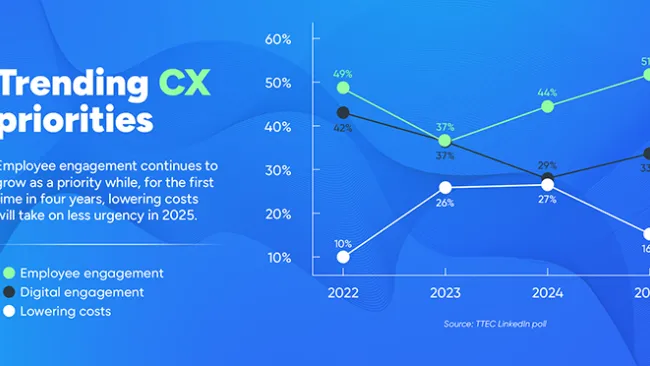It’s no secret that customer-focused companies are in vogue. Executives are embracing customer experience as a brand differentiator and media darlings like Apple and Amazon are hailed for their innovative approaches to customers. But are customer-focused businesses worth more than other businesses? The answer is a resounding “yes.”
In the age of the consumer, the businesses that thrive are obsessed with customer delight and strive to systematically exceed customer expectations. Customers reward these companies with their dollars and brand advocacy.
Research from Bain & Company shows that companies who excel in the customer experience grow revenues 4 percent to 8 percent above their market. For instance, Apple, a case study in customer-centric design and frictionless experiences, cites revenues of more than $46 billion, and enjoys 39 percent market share. And software company Adobe has inspired some users to create tattoo fan art to show their dedication to the brand, while raking in more than $4 billion in revenue in 2014.
Delighting the customer creates a moat around profits and other benefits that competitors cannot penetrate. They include more satisfied customers and employees, as well as company and economic growth. They have higher margins, because the customers just have to have the products and services that they love, and are willing to pay extra for them.
In addition, cost savings can be had at companies that aim to delight their customers, for a number of reasons. These firms compete on time and get work done faster to minimize friction. An often mistaken assumption is that cost savings implemented in one part of the organization slows things down in another part of the organization, decelerating the value to customers. However, when more efficiency is introduced with a customer focus, costs tend to come down of their own accord. The firm that delights customers also has the advantage of an unpaid (but immensely effective) marketing department. Happy customers can become some of the firm’s biggest advocates. Bain & Co. reports that promoters have a lifetime value up to 14 times that of detractors.
Many default to stock price as a measure of company value. However, evaluating the ROI of good customer experience only by total stock market returns can be misleading, according to Forrester Research. While the total stock returns of a portfolio of customer experience leaders beat those of a portfolio of customer experience laggards, there tends to be much noise in the data. The better indicator would be to compare the revenue growth of companies with superior customer experience to that of their direct competitors with relative inferior customer experience.
In addition, Forrester’s research revealed that even revenue growth is driven to different degrees by customer experience, depending on whether the company is in an industry with trapped customers, such as health insurance and traditional retailers. As the industry dynamics change, it will increase the revenue impact of customer experience.
The lesson here is that companies must take into consideration multiple factors when judging the value of their customer experience. In terms of measuring the ROI of an excellent customer experience, most Wall Street investment bankers and analysts talk about fundamental analysis, which translates to company-level financial analysis. Fundamental analysis is primarily a retrospective view or a lagging indicator of a company’s ability to generate future cash flow. This is where many Wall Street analysts miss the forest for the trees.
True fundamental analysis is the company’s ability to create engaging, emotional, and long-lasting relationships with customers, along with management’s commitment to delighting its customers. Customer experience is the prospective view and the true leading indicator of sustainable future cash flow generation.
The value of customer capital
So what does it take to become a customer-focused company? Leading companies look for ways to continually enhance the customer relationship. For example, social media outlets have created important listening posts that analysts can leverage to glean insights into companies who excel at delivering a simple and more human experience across every interaction channel.
Additionally, the companies best positioned to outperform in today’s turbulent markets create exceptional value by operating with a sense of authenticity, transparency, empathy, and societal purpose. They are developing “social capital,” creating strong emotional, personalized relationships with customers. This emotional bond is the key driver of customer loyalty, which in turn is the key driver for increasing the recurring value of their relationship with customers.
Those companies best able to exploit this reality will see an increased connection between social capital, competitive performance, and stock price performance. Omnichannel-fueled customer engagement is changing the underlying risk and growth profiles of companies and accelerating the value creation and erosion process. As a result, qualitative cues to a company’s ability to create future cash flow are becoming as important as traditional quantitative analytical and valuation metrics.
Companies must also take several factors into consideration when judging the value of their customer experience. Amazon, for example, is known for deferring profits for the sake of innovation, but also continues to capture market share with its strong customer service and investments in new areas and products.
And in today’s highly connected, always-on world, consumers have no patience for complicated communications or services. Customers appreciate services and products that save time and many are willing to pay more for a simple solution. The reality is that delighting customers often implies doing less, but with focus.
Making sure you provide a seamless customer experience across channels and empowering employees with the technology and information they need to help customers is challenging, but worthwhile.
Consider this quote from Mother Teresa: “Let no one come to you without leaving better and happier.” That’s how your customers should feel in every interaction with your company. How can you make your customer happier in every step of their journey with you?















